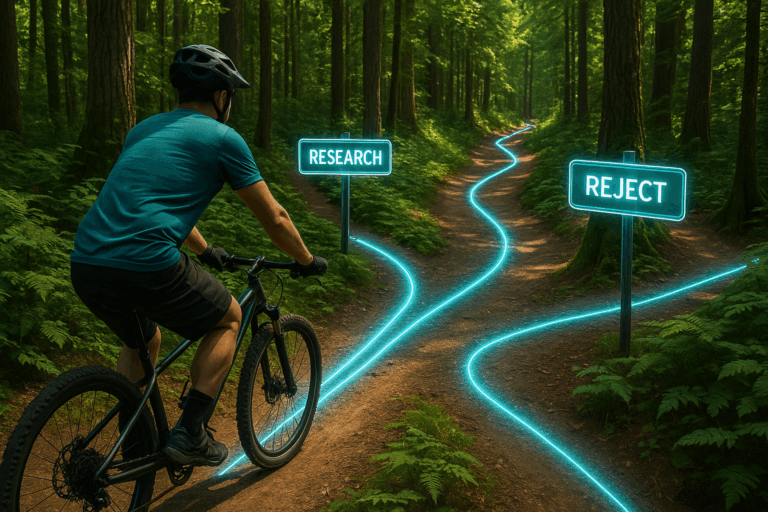
If there’s one word to describe the marketing landscape in 2025, it’s dynamic. For those of us in the trenches – whether steering a nimble startup, powering an SMB engine, or navigating the complexities of a global enterprise – the ground beneath our feet is constantly shifting. We’re facing a thrilling, yet demanding, confluence of technological acceleration, evolving consumer psyches, economic headwinds, and a race for the right talent.
This isn’t about fearmongering; it’s about foresight. The marketers who not only survive but thrive in 2025 and beyond will be those who anticipate these seismic shifts and proactively adapt. This year, five core challenges are taking center stage:
- mastering the dual-edged sword of AI,
- navigating the delicate dance between personalization and privacy,
- maximizing impact amidst tightening budgets,
- decoding the ever-elusive modern customer, and
- bridging the critical talent gap.

1. The AI Tightrope: Balancing Innovation with Real-World ROI
Artificial Intelligence is no longer a futuristic buzzword; it’s embedded in our daily marketing operations. From hyper-personalizing B2C customer journeys with uncanny precision to empowering B2B sales teams with deep analytical insights, AI’s potential is undeniable. Yet, in 2025, the honeymoon phase is over. The real challenge? Moving beyond experimentation to strategic, measurable impact.
Many organizations are wrestling with how to effectively integrate AI without succumbing to “shiny object syndrome.” The market is flooded with tools, but which ones genuinely solve core business problems? There’s also the growing concern around the quality and authenticity of AI-generated content. If everyone’s using the same algorithms, how do we maintain a unique brand voice and avoid joining a sea of generic messaging? Furthermore, the ethical implications of AI – data bias, transparency, and job displacement – loom large.
Navigating the Tightrope:
- AI as Augmentation, Not Automation Overlord: Think of AI as your most powerful intern, capable of handling heavy lifting in data analysis, content ideation, and campaign optimization, but always requiring human strategic direction and creative oversight.
- Laser Focus on ROI: Don’t invest in AI for AI’s sake. Identify specific, measurable goals – be it lead conversion rates, customer lifetime value, or content production efficiency – and choose AI solutions that directly contribute to these. Demand clear analytics and reporting from your specialized AI team members or vendors.
- Quality Control is Paramount: Implement rigorous human review processes for AI-generated content. Your brand’s reputation depends on accuracy, empathy, and a genuine connection – attributes AI struggles with.
- Upskill Your Humans: Invest in training your team to understand, manage, and ethically deploy AI tools. This isn’t just about new software; it’s about a new way of thinking, identifying the brand with the customer, and working.
- Experiment with Agentic AI: Still in the early stage of development, AI agents are the next big thing. These tools are capable of taking on assignments, not just kicking back answers to prompts. Now is the time to begin experimenting with AI agents, as we expect by next year they will be playing a significant role in forward-leaning marketing operations.

2. The Great Data Dilemma: Personalization vs. Privacy in a Post-Cookie World
Today’s customer, whether a B2C shopper or a B2B decision-maker, has a clear expectation: “You should know me, understand my needs, and make my experience relevant.” This is truly where the “why should I care?” becomes so important. This demand for hyper-personalization is a powerful driver of engagement and loyalty. Yet, it runs headlong into an equally powerful counter-current: a profound and growing concern for data privacy.
With the final crumbs of third-party cookies dissolving, marketers are facing a fundamental reset in how they collect, manage, and utilize customer data. The old playbook of broad-stroke tracking is obsolete. The new game is about building trust and providing genuine value in exchange for information. This is a particularly acute challenge for SMBs who may lack the extensive first-party data troves of larger enterprises.
Finding the Sweet Spot:
- Embrace the First Party & Zero-Party Gold Rush: Your most valuable data assets are those collected directly from your audience (first-party) and those willingly and explicitly shared by them (zero-party – think preference centers, surveys, interactive quizzes). Prioritize building these direct relationships.
- Transparency as Your Superpower: Be radically transparent about what data you’re collecting, why you’re collecting it, and how you’re using it. Make your privacy policies clear, accessible, and easy to understand. Granular consent options are key – let users choose.
- Practice Data Minimalism: Collect only the data you absolutely need to deliver value and improve the customer experience. The less data you hold, the lower your risk and the more trust you build, and the less of a chance customers will come back later to request that they “be forgotten.”
- Invest in Ethical Tech: Robust Customer Relationship Management (CRM) and Customer Data Platforms (CDP) are no longer luxuries. They are essential for ethically managing customer data, ensuring compliance, and powering meaningful personalization.
3. The Economic Squeeze: Delivering More Bang with Fewer Bucks
Let’s be frank: economic uncertainty is casting a long shadow in 2025. Inflationary pressures, fluctuating interest rates, tariff uncertainty, and overall cautious spending mean marketing budgets are under intense scrutiny. For many, the mandate is clear: achieve more ambitious goals with stagnant or even shrinking resources. This pressure is felt universally, from startups that need to make every dollar count to established enterprises expected to drive growth efficiently.
The “do more with less” mantra requires more than just wishful thinking. It demands a shift towards ruthless prioritization, hyper-efficient operations, and an unwavering focus on activities that deliver measurable returns.
Maximizing Impact Under Pressure:
- Ruthless Prioritization is Your Ally: Not all marketing activities are created equal. Conduct rigorous audits of your current initiatives. Which ones are truly moving the needle? Double down on those, and have the courage to pause or cut underperformers. If it does not ladder up to your expected outcomes, don’t waste precious resources on it.
- Embrace Agility and Iteration: Long, drawn-out campaigns with uncertain outcomes are a luxury few can still afford. Adopt an agile mindset: ideate quickly and effectively, launch, measure, learn, and iterate quickly. Small, data-driven adjustments can lead to significant gains. Rinse and repeat.
- Technology for Efficiency (Smartly): Marketing automation platforms and AI tools (with a clear ROI focus, as mentioned earlier) can streamline repetitive tasks, freeing up your team for higher-value strategic work.
- Focus on Retention & Lifetime Value: Acquiring a new customer is almost always more expensive than retaining an existing one. Invest in loyalty programs, exceptional customer service, and personalized communication to maximize customer lifetime value – a critical metric in tight economic times.
- Explore Cost-Effective Channels: Don’t underestimate the staying power of organic search (SEO), engaging organic social media content, strategic partnerships, and community building. These often require more time and creativity than cash but can yield substantial long-term results.

4. The Evolving Customer: Decoding New Behaviors and Demands
The 2025 customer is a complex creature. Whether they’re a B2C consumer researching their next gadget or a B2B buyer evaluating a SaaS solution, they are more informed, more skeptical, and more demanding than ever before. They conduct extensive online research, consult peer reviews, and expect seamless, intuitive experiences across a multitude of digital touchpoints. Their attention is fragmented, and their tolerance for generic, irrelevant messaging is virtually nil.
They expect brands to be authentic, to stand for something beyond profit, and to engage with them on their terms, often in real-time. The rise of short-form video, the expectation of interactive content, and the increasing importance of sustainability and ethical practices are all facets of this evolution.
Connecting with the Modern Buyer:
- Deep Audience Understanding is Non-Negotiable: Go beyond basic demographics. Invest in truly understanding your audience’s journey, their pain points, their motivations, and where they spend their time. Develop detailed personas and map their decision-making processes.
- Content is Still King, But Context and Authenticity Wear the Crown: Create high-value content that educates, entertains, or solves a problem. Diversifying your formats – short-form video (TikTok, Reels, Shorts) – is essential for capturing attention, while interactive quizzes, webinars, and in-depth guides can nurture deeper engagement. Crucially, let your brand’s genuine personality shine through. Authenticity builds trust far more effectively than slick polish.
- Be Omnipresent (Strategically): You don’t need to be everywhere, but you do need to be everywhere your audience is. Ensure a consistent and connected brand experience across the channels that matter most to them. Don’t guess, use data to be sure.
- Embrace Values-Driven Marketing: Modern consumers and B2B buyers increasingly favor brands that align with their values. If sustainability, ethical sourcing, or social responsibility are core to your business, communicate these commitments – whatever they may be – genuinely and consistently if they resonate with your customer.
- Prepare for New Search Paradigms: Optimize for voice search and visual search. Users are increasingly interacting with devices and platforms in new ways, and your content needs to be discoverable through these emerging channels.
5. The Talent Chasm: Finding, Nurturing, and Retaining Marketing Superstars
Underpinning all these challenges is perhaps the most fundamental: it’s still the people. The skills required to be an effective marketer in 2025 are evolving at breakneck speed. Proficiency in data analytics, AI literacy, MarTech stack management, strategic thinking, flexibility of mind, and cross-functional collaboration are no longer niche skills but core competencies.
Yet, there’s a significant gap between the skills businesses desperately need and the available talent pool. The competition for individuals who possess this blend of creative flair and analytical acumen is fierce. For startups and SMBs, competing with the salaries and resources of larger enterprises for this talent can be particularly daunting.
Building Your Dream Team:
- Invest Relentlessly in Upskilling & Reskilling: The most sustainable way to bridge the talent gap is to cultivate it from within. Provide your current team with ongoing training opportunities, access to new tools and platforms, and the space to experiment and learn. Foster a culture of continuous professional development, understanding, and empathy.
- Hire for Adaptability and Potential, Not Just Pedigree: While experience is valuable, look for candidates who demonstrate a growth mindset, a passion for learning, and the ability to adapt to new challenges. Skills can be taught; attitude is harder to change.
- Embrace Flexible Talent Models: Consider supplementing your core team with specialized freelance talent or agency partners for specific projects or skill sets, even if it’s only temporary. Remote and hybrid work models can also broaden your access to a global talent pool.
- Create a Culture That Attracts and Retains: Beyond competitive compensation, focus on building an inspiring, inclusive, and empowering work environment where marketers feel valued, can do their best work, and see clear paths for growth.

The Path Forward: Embrace the Evolution
The marketing landscape of 2025 is undeniably complex, but it’s also ripe with opportunity. The challenges we’ve discussed – AI integration, data privacy, economic pressures, evolving customer demands, and the talent crunch – are not insurmountable obstacles. They are invitations to innovate, to think more strategically, and to build deeper, more meaningful connections with our audiences.
By embracing agility, fostering a culture of continuous learning, prioritizing ethical practices, and relentlessly focusing on delivering genuine value, marketers can navigate this new frontier and lead their organizations to unprecedented success. The future of marketing is here, and it belongs to those who dare to be bold, adaptable, and deeply human.
What are the biggest marketing concerns or opportunities you see for 2025?
Share your thoughts with the Bold team or let us know how we can help.
